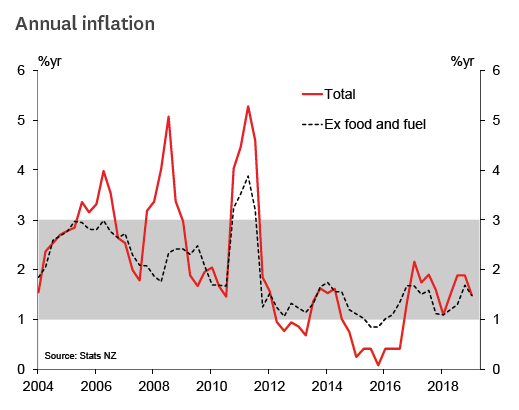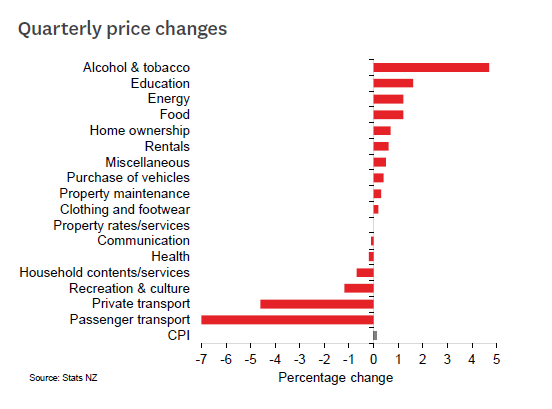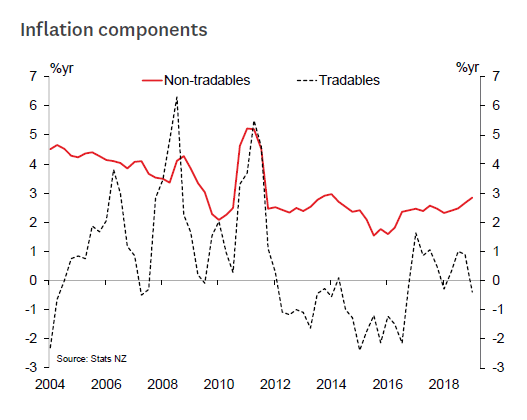- The Consumer Price Index (CPI) rose by 0.1% in the March quarter, a little less than expected.
- Annual inflation slowed from 1.9% to 1.5%, largely reflecting a pullback in fuel prices over the quarter.
- However, measures of underlying inflation also remain subdued. Imported inflation is soft and domestic inflation is picking up only gradually.
- Market pricing is now leaning towards an OCR cut in May, but we emphasise that this remains a close call.
Inflation in New Zealand remains on the subdued side, despite a gradual pickup in domestic price pressures. The CPI rose by 0.1% in the March quarter, taking the annual inflation rate down to 1.5%. The quarterly result was a touch below the 0.2% rise that we and the Reserve Bank expected, and below the median market forecast of a 0.3% rise.
Financial markets reacted swiftly, with the New Zealand dollar falling by around 1% to 0.67 and the two-year swap rate falling by 11 basis points to 1.62%. Market pricing has now shifted to a better than even chance of an OCR cut at the May Monetary Policy Statement.
As it happens, we agree with that pricing – we switched to calling a May OCR cut a couple of weeks ago. But as RBNZ Governor Adrian Orr has emphasised in recent interviews, the outcome of the May review is far from settled. It’s not obvious that today’s result would tip the scales towards a May OCR cut: inflation is only slightly below where the RBNZ expected it to be at this point, and all of the surprise was on the more volatile tradables side.
Meanwhile, non-tradables inflation is gradually picking up, as the RBNZ would have hoped. But it needs to rise further to be consistent with a sustained return to 2% overall inflation. The question for the RBNZ will be whether current policy settings are enough to achieve that, in the midst of concerns about slower growth both here and internationally.
Details
The 0.1% increase for the March quarter saw annual inflation slow from 1.9% to 1.5%, matching the pace seen in the June quarter last year. The various measures of ‘core’ inflation, which exclude large price movements, were largely in a range of 1.5-1.7%.
The biggest contributor to the slowdown in annual inflation was petrol prices. The 7% drop in prices for the quarter meant that they went from being up around 11% year-onyear to almost flat. Fuel prices have started to rise again in recent weeks, though it will take some time before this boosts the annual inflation rate again.
Tradables prices fell by 1.3% in the March quarter, and were down 0.4% on a year ago. Aside from fuel prices, the biggest contributor was a 12% seasonal decline in international airfares.
Retailers’ pricing power remains subdued in the importheavy tradables categories such as electronics and home furnishings. That said, it’s not necessarily weaker than was already believed. There were several overs and unders relative to our forecast, and a single item – a 6.7% plunge in furniture prices, the biggest fall on record – accounted for effectively all of the surprise for us.
In contrast, non-tradables prices rose by 1.1% as expected, with the annual increase lifting slightly to 2.8%. The annual increase in tobacco excise duty was the biggest positive contributor – although by less than expected, with signs that retailers are struggling to maintain cigarette prices at such high levels. Accommodation and car rentals rose by more than we expected during the peak travel season, but domestic airfares were a bit softer.
Housing-related items make up a significant chunk of nontradables, and they continued to make steady contributions in the March quarter. New dwelling prices rose by 0.7%, with some signs of renewed momentum in Auckland and Canterbury – a little surprising given the cooling in house sale prices in those regions. Rents rose by 0.6%, maintaining the pace of recent quarters.
Looking ahead, we expect the June quarter CPI to be stronger than today’s result. Fuel prices are heading up again, the minimum wage increase in April is likely to come through in the cost of eating out, and Stats NZ will be adopting a new method of calculating rents that tends to track a bit higher than the old method. But with the persistent headwinds to tradables inflation in particular, we expect annual inflation to remain below 2% through to the end of this year.
















